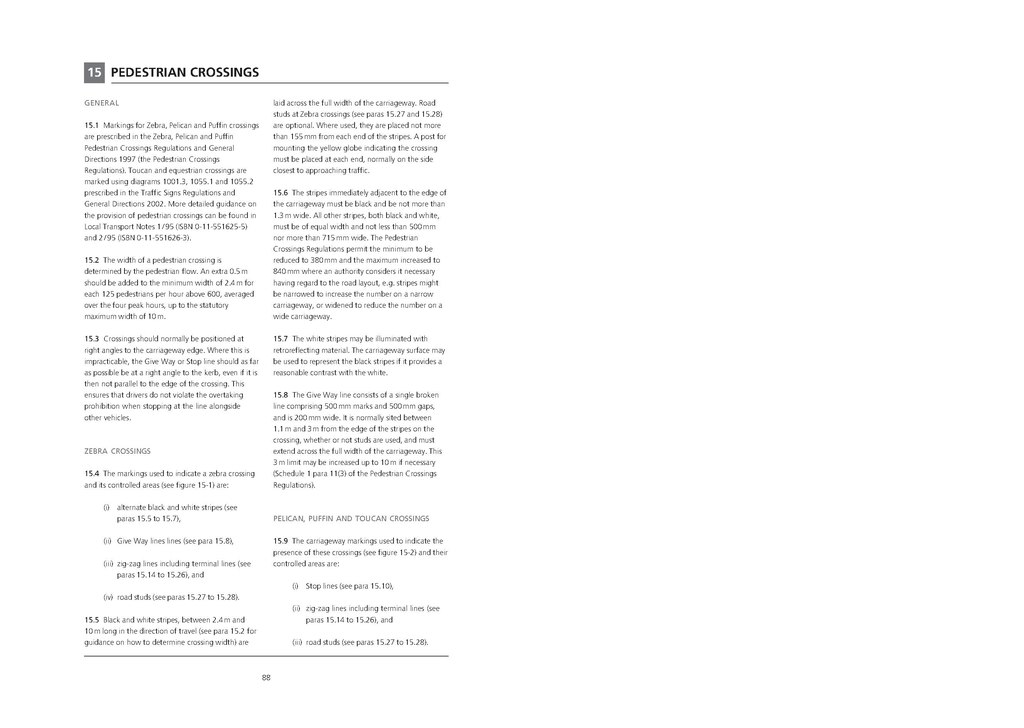15PEDESTRIAN CROSSINGS
GENERAL
15.1 Markings for Zebra, Pelican and Puffin crossings are prescribed in the Zebra, Pelican and Puffin Pedestrian Crossings Regulations and General Directions 1997 (the Pedestrian Crossings Regulations). Toucan and equestrian crossings are marked using diagrams 1001.3, 1055.1 and 1055.2 prescribed in the Traffic Signs Regulations and General Directions 2002. More detailed guidance on the provision of pedestrian crossings can be found in Local Transport Notes 1 / 95 (ISBN 0-11-551625-5) and 2 / 95 (ISBN 0-11-551626-3).
The width of a pedestrian crossing is determined by the pedestrian flow. An extra 0.5 m should be added to the minimum width of 2.4 m for each 125 pedestrians per hour above 600, averaged over the four peak hours, up to the statutory maximum width of 10 m.
Crossings should normally be positioned at right angles to the carriageway edge. Where this is impracticable, the Give Way or Stop line should as far as possible be at a right angle to the kerb, even if it is then not parallel to the edge of the crossing. This ensures that drivers do not violate the overtaking prohibition when stopping at the line alongside other vehicles.
ZEBRA CROSSINGS
15.4 The markings used to indicate a zebra crossing and its controlled areas (see figure 15-1) are:
(i) alternate black and white stripes (see paras 15.5 to 15.7),
(ii) Give Way lines lines (see para 15.8),
(iii) zig-zag lines including terminal lines (see paras 15.14 to 15.26), and
(iv) road studs (see paras 15.27 to 15.28).
15.5 Black and white stripes, between 2.4 m and 10 m long in the direction of travel (see para 15.2 for guidance on how to determine crossing width) are laid across the full width of the carriageway. Road studs at Zebra crossings (see paras 15.27 and 15.28) are optional. Where used, they are placed not more than 155 mm from each end of the stripes. A post for mounting the yellow globe indicating the crossing must be placed at each end, normally on the side closest to approaching traffic.
15.6 The stripes immediately adjacent to the edge of the carriageway must be black and be not more than 1.3 m wide. All other stripes, both black and white, must be of equal width and not less than 500 mm nor more than 715 mm wide. The Pedestrian Crossings Regulations permit the minimum to be reduced to 380 mm and the maximum increased to 840 mm where an authority considers it necessary having regard to the road layout, e.g. stripes might be narrowed to increase the number on a narrow carriageway, or widened to reduce the number on a wide carriageway.
15.7 The white stripes may be illuminated with retroreflecting material. The carriageway surface maybe used to represent the black stripes if it provides a reasonable contrast with the white.
PELICAN, PUFFIN AND TOUCAN CROSSINGS
15.8 The Give Way line consists of a single broken line comprising 500 mm marks and 500 mm gaps, and is 200 mm wide. It is normally sited between 1.1 m and 3 m from the edge of the stripes on the crossing, whether or not studs are used, and must extend across the full width of the carriageway. This 3 m limit may be increased up to 10 m if necessary (Schedule 1 para 11(3) of the Pedestrian Crossings Regulations).
15.9 The carriageway markings used to indicate the presence of these crossings (see figure 15-2) and their controlled areas are:
(i)Stop lines (see para 15.10),
(ii) zig-zag lines including terminal lines (see paras 15.14 to 15.26), and
(iii) road studs (see paras 15.27 to 15.28).
88
